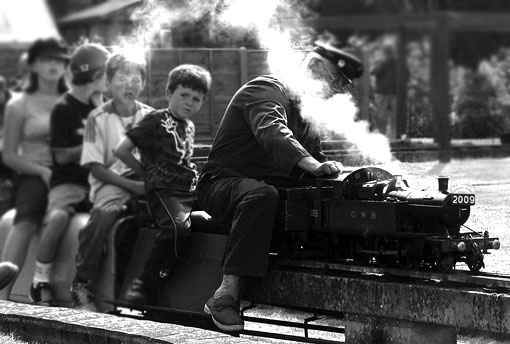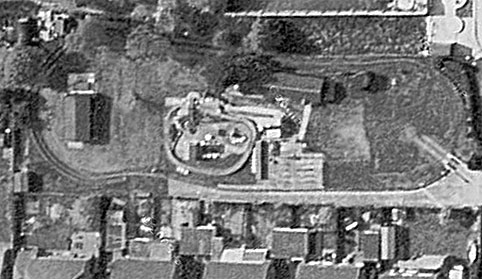Awesome train set is *awesome*
What, geeks like trains? Huh. Who knew?
It rained like a bastard all day today and we did exactly Jack and Shit, so have some more trains, Poindexters.
This here is from the Romney Marsh Model Engineering Society, which we visited last year and I somehow never got around to writing about. It is huge. They have six permanent tracks in three gauges.
On the day we visited, they were running about five of these little steam engines and one electric. Plus a bunch of tiny models on the track in the center.
The tracks are huge. Did I mention huge? Here’s a screencap from Google maps. I’m pretty sure those houses at the bottom are semi-detached (what we would call duplexes).
I was going to call it the awesomest train set ever, but this being England, undoubtedly…no.
Posted: August 25th, 2010 under britain, personal, technology.
Comments: 20
Comments
Comment from Nina from GCP
Time: August 25, 2010, 11:00 pm
I like trains, in a casual-likes-to-go-to-the-CA-State-Railroad-Museum-every-couple-o’-years kind of way. Not liking to fly, I’d love to have quality train service available as an alternative.
But this does look like a cool place to visit.
Comment from Monotone The Elderish
Time: August 25, 2010, 11:16 pm
nope not liking the flying either… trains are better… they arent 15,000 ft up…..
Comment from Ric Locke
Time: August 25, 2010, 11:32 pm
I’d have a hard time thinking of someone who didn’t like trains, especially steam trains, as a proper geek. Not necessarily a full-blown, have-its-babies obsession, but at least like Nina, “o wow that’s cool” sort of thing. We once had a convention in Baltimore, and held the main dinner in the railroad museum there. Geeks vs. managers was blatantly obvious — all the geeks were peering at the works on display, and the suits were all standing around wondering what the interest was…
Steam engines are great. All those moving parts out on display, polished rods and cams and bearings and grease flying around. It almost looks alive, doesn’t it, like some mechanical relative of beetles and spiders, and the throb-throb-throb is very like a heartbeat. I long ago noted that the rhythms of ragtime merge perfectly with the sound of a Consolidation making a grade.
Regards,
Ric
Comment from Can’t hark my cry
Time: August 25, 2010, 11:44 pm
It’s not just the trains themselves–it’s the stations (or was until the late 60s in America, when they replaced so many of the grand soaring urban ones with ugly little practical pig huts, but let’s not go there!), and the literature. It seems as if half the books I loved as a child involved at least one scene in a train station or on a train, and while that proportion has diminished in adulthood, there’re still plenty of wonderful train scenes. Airports? Scenes on planes? Strictly cliffhanging thriller how-soon-can-we-have-a-disaster. No coincidence that the only way to get to Hogwarts is by train. . .
Comment from Uncle Badger
Time: August 26, 2010, 12:07 am
Don’t make us upload that video footage, Can’t Hark 😉
Comment from Scubafreak
Time: August 26, 2010, 12:32 am
Well then, here is an oldie but a goodie:
The Space Shuttle and the Horse’s Rear End
Say friend, did you know that the US Standard railroad gauge (distance between the rails) is 4 feet, 8 1/2 inches.
That’s an exceedingly odd number. Why was that gauge used?
Because that’s the way they built them in England, and the US railroads were built by English expatriates.
I see, but why did the English build them like that?
Because the first railway lines were built by the same people who built the pre-railroad tramways, and that’s the gauge they used.
Well, why did they use that gauge in England?
Because the people who built the tramways used the same jigs and tools that they used for building wagons, which used that wheel spacing.
Okay! Why did their wagons use that odd wheel spacing?
Because, if they tried to use any other spacing the wagon wheels would break on some of the old, long distance roads. Because that’s the spacing of the old wheel ruts.
So who built these old rutted roads?
The first long distance roads in Europe were built by Imperial Rome for the benefit of their legions. The Roman roads have been used ever since.
And the ruts?
The original ruts, which everyone else had to match for fear of destroying their wagons, were first made by the wheels of Roman war chariots. Since the chariots were made for or by Imperial Rome they were all alike in the matter of wheel spacing.
Thus, we have the answer to the original question. The United States standard railroad gauge of 4 feet, 8 1/2 inches derives from the original specification for an Imperial Roman army war chariot.
And the motto of the story is Specifications and bureaucracies live forever.
So, the next time you are handed a specification and wonder what horse’s ass came up with it, you may be exactly right. Because the Imperial Roman chariots were made to be just wide enough to accommodate the back-ends of two war-horses.
So, just what does this have to do with the exploration of space?
Well, there’s an interesting extension of the story about railroad gauge and horses’ behinds. When we see a Space Shuttle sitting on the launch pad, there are two big booster rockets attached to the sides of the main fuel tank. These are the solid rocket boosters, or SRBs. The SRBs are made by Thiokol at a factory in Utah. The engineers who designed the SRBs might have preferred to make them a bit fatter, but the SRBs had to be shipped by train from the factory to the launch site.
The railroad from the factory runs through a tunnel in the mountains. The SRBs had to fit through that tunnel. The tunnel is slightly wider than a railroad track, and the railroad track is about as wide as two horses’ behinds.
So a major design feature of what is arguably the world’s most advanced transportation system was originally determined by the width of a horse’s ass.
Comment from Can’t hark my cry
Time: August 26, 2010, 12:36 am
Ooooh, Uncle Badger, were there excellent stations? Nevermind–I’ll just imagine something M.R.James/E.Nesbit-ish. . .
I have to admit, though, that I kinda regret the passing of the practical-pig Albany New York station. In the ’60s they moved the station out of the city, across the Hudson River to Rensselaer, and built the then-standard modified quonset hut in yellow and gray. Next to about 5 acres of parking. Fast forward to the ’90s. Unless you were there at dawn or thereabouts, you had to park on the perimeter of the lot, walk across to the station in the middle of one side of the lot, buy your ticket and walk across the station (maybe 50 yards) out onto the platform. Graceless and tasteless. So they built a new station on the adjoining bluff. Wouldn’t you think that making things easier and better for passengers would have been a priority in the design phase?
Now the station sits well ABOVE the tracks, on top of a TINY parking garage. So, unless you get there the night before, you STILL have to park at the perimeter of the lot. And walk across the ENTIRE lot, not just half of it. And take the elevator up two floors to the station interior. Then take the escalator down two floors to the tracks.
Pretty it is–but from the point of view of efficient and comfortable movement, a net loss.
Comment from Can’t hark my cry
Time: August 26, 2010, 12:48 am
Scubafreak–I ask this not in a combative spirit but because I’m truly curious. . .and I think this might be a place where people have the TECHNICAL answers I thirst for.
I’ve read the Snopes article that says that particular bit of Internet lore is more or less accurate, but there’s a piece I REALLY don’t understand–(well, there were two pieces in the article Snopes deconstructed that I didn’t understand, but I see your version leaves out the “two-horses’-asses-wide” bit). Because roads, all roads, need periodic repair. So, surely they filled in the ruts on a regular basis? And, yes, I know all the stuff about what miraculously excellent road builders the Romans were, but the inhabitants of the places they left their roads were surely smart enough to have figured out how to make those fill-ins stand up to reasonable wear and tear?
Comment from Cobrakai99
Time: August 26, 2010, 12:49 am
@ Can’t Hark: And I was just going to mention how the Rensselaer station was a good looking station to replace the old pigbox. However, I see your point and have only been in the station as a stop on the way home from the airport after it was built to see it. I have never had to use it as a passenger. I do have plenty of fond memories in the pigbox, including meeting David Hyde Pierce (he was dropping off a relative for the same train we were putting my cousin on). The AMTRAK train was late, but I state the obvious there, and we got to have a small coversation with him, thanks to my aunt , while we waited. He was very nice and delt with us pestering fans extemely well.
Comment from Can’t hark my cry
Time: August 26, 2010, 12:56 am
Cobrakai99
Oh, it is a beautiful station, no question–and the old one was UGLY! As were (and are!) all the cookie-cutter Amtrak stations of that era. It just saddens me that when designing it noone seems to have spent any time truly thinking about the experience of the average passenger.
Yes, that’s one of the other things about train stations–they tend to be pretty egalitarian, although I’ll confess to having enjoyed taking advantage of the First Class Passengers’ Lounge (padded armchairs!) in Chicago when switching from the Lake Shore Limited to the Texas Eagle. An 8 hour wait. . .and both trains were on time!
Comment from Uncle Badger
Time: August 26, 2010, 1:23 am
Yes, very MR James!
The Kent and East Sussex Railway was built by an extraordinary figure – Colonel Holman F. Stephens.
Despite the military rank, he had been brought up by artistic parents who were well connected with the pre-Raphaelites (hence the ‘Holman’). But young Fred wanted to be an engineer, not a painter, so after a stint in the Great War, he went on to build a succession of almost hopelessly quixotic rutal railways all across the country – places where towns were too poor, or too remote, or had just been overlooked during the ‘Railway Mania’ of the 1800s.
It was a make do and mend railway. Secondhand locomotives and ancient hand-me-down cariages trunded idly through the countryside, serving isolated stations, often little more than gas or oil lit corrugated iron sheds with planking for platforms.
His railways rarely turned a profit and the Lord knows how the good Colonel kept them afloat (indeed, sometimes he didn’t).
But if you want spooky, a Colonel Stephens station, an oasis in a corrugated hut, lit by of a handful of sputtering oil lamps and a coal stove, mlles from the town it purported to serve – miles to be walked in the driving rain, or the bitter cold, through arches of owl-haunted trees, silent fields and the relentless wind – certainly takes some beating!
Comment from Can’t hark my cry
Time: August 26, 2010, 1:37 am
Oh! My! Yes–that is the distilled essence of a certain type of ghost story (and, quite apart from James, I am a ghost story afficianado, if I do say so as shouldn’t!)
Um.
I don’t suppose you could start the upload just before the mustelid household retires to a well-earned repose? I’m not nagging or whining here. . .but gee, that really would be fun.
However. I’m an adult, and can assuage my desire with the solace of imagination. Really. Yup.
Comment from Scubafreak
Time: August 26, 2010, 1:38 am
Hark – as I understand it, the Romans were the the only government that built roads on a National level until relatively recently. In between the Modern government and Roman rule, roads were a fairly provincial affair, and not subject to modern standards of maintanance. So, given the standards of the time, they likely figured that “If it ain’t broken, why spend money fixing it?”
Hence, the continuation of the ruts in the roads.
Comment from Uncle Badger
Time: August 26, 2010, 1:53 am
You know, on (mature and considerred, of course!) reflection, what we need to do is snip together some bits and post a single entity (um, if that’s not quite the wrong word!).
The trouble is, they were filmed on a sunny, August afternoon….
That said, Her Grest Stoatliness (whos is, inter alia Mistress Of Ye Darke Software) has slouched off to Bethlehem and I, the rougher beast, am on my way shortly…
Video will follow….
Comment from Can’t hark my cry
Time: August 26, 2010, 1:59 am
Scubafreak:
‘k, this probably veers from the realm of pure curiosity into a more confrontational mode–so feel free to make rude comments and hand gestures. You may take into consideration that I am at heart a timid soul.
At the same time, I am by upbringing, education, training and profession inclined to weigh and evaluate information and the conclusions which can be drawn from it. And I’m really having a problem with the rut thing. I guess I just can’t postulate a 9th century blacksmith saying “Oh, no, Cedric, I can’t create a wagon with wheels that are more than 4’ 8.5″ (in Roman/Saxon units) apart because it will be shaken to bits when you drive it on the rutted Roman road.” So, I have a hard time with the “they didn’t broaden the axle because of the ruts” explanation. I do believe (what Snopes seems to endorse) the concept that basically when asked to build successive waves of vehicles, vehicle builders used what they already had; but I am sceptical of the assertion that that had anything to do with ruts.
Comment from Pavel
Time: August 26, 2010, 2:00 am
As well, I think at least some of the Roman roads were paved with various types of stone, and repairing the road meant replacing sometimes huge slabs. If you visit Ephesus, the roads are paved with big slabs of marble. The chariot ruts are still there.
Comment from Can’t hark my cry
Time: August 26, 2010, 2:06 am
Uncle Badger–even if the falcon cannot hear the falconer, I know neither you nor Ms. Weasel would loose mere anarchy upon the world. . .so I will await, perhaps, a shape with lion body and the head of a man, a gaze blank and pitiless as the sun. Or, in the alternative, judiciously edited snips of The Glorious Railway Journey of a Stoat and a Badger
Comment from Scubafreak
Time: August 26, 2010, 2:11 am
Hark, ya don’t wanna go there. My confrontational side usually includes crude gestures with my swinging Cod, and wierd Ringo Starr quotes from CAVEMAN.
Considering that I’m at work right now, that might just cause a bit of consternation with my cubemates…… 😉
(or unbridalled laughter, I’m not eager to find out)
((Oh God, am I really that sleep deprived?))
Comment from Can’t hark my cry
Time: August 26, 2010, 2:17 am
Scubafreak: Oh, no, no, no, no, no. I do NOT want you to end up with consternated cubemates. . .or the object of unbridled laughter! Take a deep breath! Set it ASIDE! You can respond later. . .I don’t actually mind crude gestures, swinging (um) objects, or caveman remarks. Just don’t do it while at work, ‘k? And, um, well, Oh, nevermind!
Comment from David Gillies
Time: August 26, 2010, 6:32 am
If you like this, you will go into spasms over the Romney, Hythe and Dymchurch railway. It’s a 15″ gauge railway that runs all the way from Hythe down to Dungeness (13 miles!) You must, must, MUST experience it. Somewhere amongst my mother’s boxes of yellowing snaps is a set of pictures from when I as a twelve year-old got to ride it with my parents and sister. It’s stunningly pointless as a tourist attraction: no-one goes to Dungeness except to work at the nuclear power station, so when you get to the end of the line, you wander about for a bit and then go straight back, but it goes through some of the most appealing coastal scenery in Southern England. If, on the other hand, you live near one of the stations, I dare say it’s quite practical.














Write a comment
Beware: more than one link in a comment is apt to earn you a trip to the spam filter, where you will remain -- cold, frightened and alone -- until I remember to clean the trap. But, hey, without Akismet, we'd be up to our asses in...well, ass porn, mostly.<< carry me back to ol' virginny